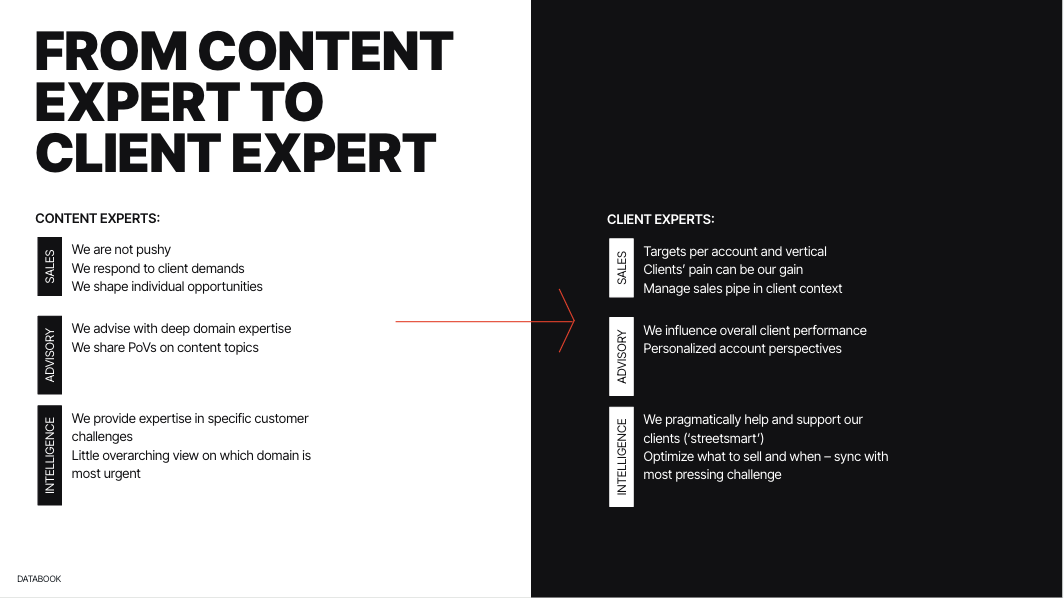Selling consulting services takes more than a strong brand and good people. With costs on the rise and competition stiffening, you need to create a unique value proposition to drive revenue and grow your business. Sales growth in the consulting industry is under pressure. Costs are rising, and companies are hiring more experts to keep up with demand. But is this enough?
Let’s explore the challenges consulting companies face when trying to grow their sales and how to overcome them. We'll discuss account and territory management, generating new pipeline, sales and pipeline management, and the importance of positioning with business value. With these insights, you'll be better equipped to drive sales growth in your company.
True Consulting Sales Growth Goes Beyond Price, Proposition, and People
Professional services firms have a tendency to focus on Price, Proposition and People. But that’s only half of the sales growth equation. If you want to grow sales, you also need to consider:
- Optimizing your territory and account management
- How and from where new client origination occurs
- Sales and pipeline management
Let’s examine these challenges in more detail.
1. Account and Territory Management
All too often, account focus is based on history rather than recent client context–who is already working this territory, what the account’s situation was in the past, etc. Sellers are assigned to accounts based on tenure rather than client fit. That’s not always the right move. This inside-out approach is more about your convenience than your clients’ context. High-value strategic relationships are never so one-sided!
2. Generating new pipeline
When origination is based on who your sellers know rather than who is actually the right fit, you have a problem. Why? Because squeezing in too many topics with the wrong person, hoping to strike a resonant chord, only dilutes the impact of your message—and it won’t impress enough to get you a meeting with a CxO. Even if your CEO does outreach, your clients can tell from the lack of specific perspective that the intent of their communication is to fill pipe, not give real value. Functional transformation should be positioned by addressing business value, not by simply selling products or services.
3. Sales & Pipeline Management
Another missing piece of the puzzle is sales and pipeline management. We’ve seen many consulting firms not track this at all. But even when pipeline reports exist, they don’t focus on insights or observations that actually pertain to the potential client’s perspective. Big deals fester in pipeline for a long time without regular check-ins of client context. Short-term pressure on selling ‘something’ to cover chargeability can lead to suboptimal decision making and execution.
None of these lay the groundwork for an effective relationship, causing your ARR and even your reputation to suffer.
Challenges in the Consulting Industry
Sales growth in the consulting industry comes at a high cost. Peer benchmarking data from the Strategic Relationship Management Platform Databook shows a 32% increase in sales and marketing expenses since FY2020. Most consulting companies solve for these challenges by hiring an army of experts with domain expertise. However, just throwing warm bodies at the problem is not enough in today's economic environment.
Stop me if this sounds familiar:
- Most of your MDs focus on the functional challenges within their domain strategy. Because they’re stuck on the client’s install base, they don’t spend enough time on the broader client strategy.
- The average deal size for a consulting project is $150-200K, which is relatively low compared to the $2-3K ADR.
- Your teams consist of domain experts. That’s great, but leaves account oversight and account management as an afterthought.
- Sales and pipeline reports are out there, but there’s no real sales cadence in place. This is especially true for net-new meetings or WEB (the “Worst, Expected, Best” view of client partner on opportunities).
- When it comes to new client opportunities, your team is able to be reactive, but not proactive. Origination is difficult, leading to suboptimal chargeability driven by significant and scattered business development effort.
Part of this is because functional domain sales limit your team’s ability to create strategic account relationships. It’s a classic problem in professional services sales. Where are these challenges coming from?
Let’s start with C-suite meetings. You need their support to seal the deal, and a positive outcome is far from guaranteed. C-level pitches are often inside out–focused on your offering–instead of purely focused on client value, need, and urgency. Presentations with this inside-out focus take significant time to prepare, only to miss out on recent client context and industry changes. Not only does this approach waste time, but it also results in outdated pitches that no longer resonate.
Building pipeline is another challenge. Instead of addressing the business value at stake and linking it to solution themes that can engage multiple C-suite leaders, pipeline is often created through specific dilemmas or questions within client relationships, which by default tend to be siloed within a single part of the organization. The result? Pipeline is very volatile, making it difficult to allocate business development personnel.
The best selling sales book The Challenger Sale describes high-performing sellers as Challengers. Bluntly, consultants don’t always follow the Challenger approach, answering the question at hand instead of addressing the broader value at stake. To do this right, consultants need greater access to industry and financial benchmarks and a deeper understanding of their clients’ management intent. Without this, opportunities stay small.
Meeting preparation is a huge timesuck. Even if you can use automation to support your presentation creation (and most don’t), sellers often miss recent client context. They’ve spent hours or even weeks of time crafting a self-centered pitch that misses the full business and financial impact that your customer actually needs to hear.
Combine all these factors and it’s clear why forecasting is also a challenge. How can sales or revenue leadership accurately forecast? These inaccurate forecasts lead to suboptimal resource allocation, affecting profitability and starting the entire cycle again.
How to Build a Client-Focused Professional Services Sales Strategy
In order to be successful in today's consulting sales environment, sellers need to shift their focus from being content experts to being client experts. Content experts are described as responsive to client demands, not pushy, and able to advise with deep domain expertise. However, they lack an overarching view on the client’s most urgent priorities.
Client experts are a level above. They target specific accounts and verticals, position client pain as an opportunity, influence overall client performance, and can optimize what to sell and when.

Most MDs who work in consulting today are content experts. But that doesn’t cut it anymore. In order to be successful in today's environment, consultants need to focus on becoming client experts. Client experts are better equipped to target specific accounts and verticals, position client pain as opportunity, influence overall client performance, and optimize what to sell and when. By shifting focus, consulting firms can improve forecasting accuracy, engage in proactive selling practices, and ultimately improve their bottom line.
Want to arm your team with the tools to become client experts? Join the Strategic Sales Network to further sharpen your business development skills.


